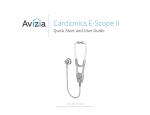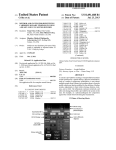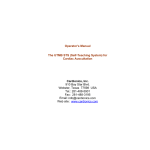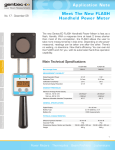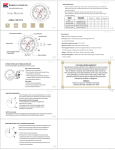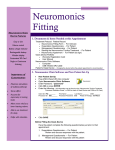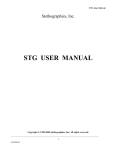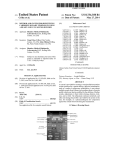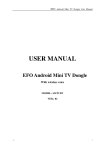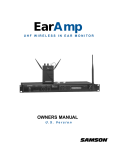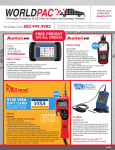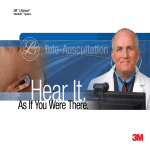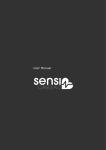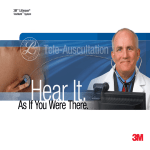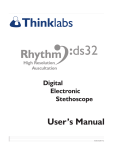Download The E-Scope® Electronic Stethoscope
Transcript
The E-Scope® Electronic Stethoscope Catalog of Products Cardionics, Inc., 910 Bay Star Blvd., Webster, Texas 77598 USA Telephone: 281-488-5901 Toll-free USA & Canada 1-800-364-5901 Web: www.cardionics.com Email: [email protected] Contents Description Page No. Summary chart........... .......................................................................1 E-Scope Product description .............................................................2 E-Scope for General Clinical Use……………………………. .......4 EMS use in Ambulance (new)........................................................7 In-the-ear (ITE) hearing aids ............................................................8 Behind-the-ear (BTE) hearing aid………………………………… 10 E-Scopes for Special use ...................................................................13 Accessories for ITE hearing aid……..…… ………………………14 Accessories for BTE hearing aids………………………………….16 Accessories for Teaching......................……………………………18 pocketMonitor Software (new)………………………………….19 Service or technical information …………………………………..21 Index ………………………………………………………………22 ®E-Scope is a registered trademark of Cardionics, Inc., Webster, Texas 77598 ™ Specialist & Pocket Monitor are trademarks of Cardionics, Inc. Webster, Texas 77598 b Summary of Use – E-Scope Electronic Stethoscope Where Used Cat. no. Description General clinical use Pediatrics 718-7700* 718-7740** 718-7745*** Veterinary use 718-7700 With ITE hearing aid 718-7710* 718-7750** With BTE hearing aid 718-7712** With Implant Cochlear or Baja 718-7712** Special Use 718-7712** with ear buds Ambulance/EMS use 718-7800* Professional Model E-Scope Professional Model E-Scope with Specialist Pediatric Bell. Professional model E-Scope Hearing Impaired E-Scope with headphones Hearing Impaired E-Scope without headphones, but with Specialist heads Hearing Impaired E-Scope without headphones, but with Specialist heads Hearing Impaired E-Scope without headphones, but with Specialist heads E-Scope EMS with aviation style headphones Recommended Accessories None Page Number 4 None 5 Low frequency headphones None 4 DAI or Silhouette Cables 10 Speech processor Cable set None Call for information Ear buds 13 None 7 8 * Supplied with Specialist Adult Diaphragm ** Supplied with Specialist Adult Bell & Specialist Adult Diaphragm *** Supplied with Specialist Pediatric Bell, Specialist Adult Bell & Specialist Adult Diaphragm 1 Description - Common to all E-Scope® Models Features and Benefits Cardionics supplies three basic types of E-Scopes – E-Scope Clinical Model, EScope Hearing Impaired Model and the E-Scope EMS. Various accessories are added to adapt these E-Scopes to different procedures and applications. Slim-line design. The E-Scope is a slim-line design that easily wraps around the neck when not in use. It is lighter than an acoustic stethoscope. Fingertip Control. All the controls for volume and heart sound or breath sound filters are on the head of the stethoscope making it easy for the user to set the volume or filter. Volume control. On the stethoscope head, there is a (+) and (–) symbol that allows the user to increase or decrease the sound level. Filter control. A frequency switch for heart sounds (45-900 Hz) and breath sounds (50-2000 Hz). This allows the listener to concentrate on a particular sound Automatic shut off. The E-Scope shuts off automatically at or about two minutes. Cardionics also has models with 8, 30 and 60 minute shut off timers available upon request at no additional charge at the time of order. Automatic volume restart. The E-Scope remembers the last volume setting so that when it is turned on, the volume will be set to the previous volume. Off-the-Shelf Battery. The E-Scope uses a standard off-the-shelf AAA battery that operates the E-Scope for 4-5 months assuming usage at 30 times per day, 6 days per week. Replacement batteries are available at any supermarket or drug store. Extra ear tips. The E-Scope is supplied with two additional types of ear tips so the user can select the most comfortable – soft rubber, hard plastic or mushroom type. Ability to change heads. Most electronic stethoscopes have a fixed diaphragm with an electronic switch to change to a bell. Most physicians, however, prefer a physical bell as is found on a standard acoustic stethoscope. A real bell allows the physician to listen to lower frequencies in a manner in which he/she is most accustomed. A bell is used to listen to the lower frequencies and has no diaphragm touching the skin. By pressing the bell on the skin, it can be stretched forming a natural diaphragm. Selection of diaphragms and bells. The E-Scope is supplied with an adult and pediatric diaphragm as well as three sizes of bells – adult, pediatric and infant. 2 E-Scope Electronic Stethoscope – General Description Features and Benefits (Continued) Less amplification of room noise. The design of the E-Scope significantly reduces the amplification of unwanted outside room noise when used in the heart sound setting. When used in the lung sound setting, there is a little more noise introduced due to the wider frequency band. Maximum Amplitude. For the E-Scope II, the maximum amplitude or sound pressure level output without distortion is 120 dB at 100 Hz. This is about 30 times louder than an acoustic stethoscope. Operator’s Manual and Instructional CD-ROM. A complete Operator’s Manual as well as an informal instructional CD-ROM is included with each E-Scope. Specialist™ Bell and Diaphragm. Cardionics supplies a Specialist Adult Diaphragm as standard on all E-Scopes. An optional Specialist Adult Bell and Specialist Pediatric Bell are available. The performance of the Specialist Adult Diaphragm has a 3 dB (or 50%) higher output than the standard Diaphragm over the 20 to 200 Hz frequency range. Specialist is a trademark for a series of chest pieces machined from high-grade stainless steel. Specialist Pediatric Bell. The Specialist Pediatric Bell output has, on average, about 60% higher than the standard pediatric bell over a 50 to 200 Hz frequency range for both heart and breath sound filter settings. Warranty: One year - parts and labor. Below is a photo and description of each model E-Scope supplied by Cardionics. The description will be the same as above except when indicated. 3 E-Scope Electronic Stethoscope - Clinical Model Cat. no. 718-7700 Suggested Application: Professional Clinical Use. E-Scope Electronic Stethoscope, Clinical Model Specialist™ Adult Diaphragm (supplied) Description: Same as general description except that the Professional Model E-Scope (shown above) will be supplied with a Specialist Diaphragm as a standard item effective April 15, 2005. This E-Scope is designed for professional clinical use. In addition to the Specialist Diaphragm, this E-Scope is supplied with a pediatric diaphragm as well as three sizes of plastic bells – adult, pediatric and infant. E-Scope head with Specialist Adult Bell E-Scope head with Specialist Adult Diaphragm 4 E-Scope Electronic Stethoscope - Pediatric Model Cat. no. 718-7745 Suggested Application: Professional Clinical Use in Pediatrics and Adult patients . E-Scope Electronic Stethoscope, Clinical Model With Specialist Pediatric Bell, Specialist Adult Bell And Specialist Adult Diaphragm. Specialist Pediatric Bell, Specialist Adult Bell and Specialist Adult Diaphragm (supplied) Description: Same as general description except that the Clinical Model E-Scope (shown above) is supplied with three Specialist heads – the Specialist Pediatric Bell, Specialist Adult Bell and Specialist Adult Diaphragm. This E-Scope is designed for professional clinical use with emphasis on pediatrics. In addition to the Specialist heads, this E-Scope is also supplied with a pediatric diaphragm. 5 E-Scope Electronic Stethoscope - Clinical Model with Specialist heads Cat. no. 718-7740 Suggested Application: Professional Clinical Use. E-Scope Electronic Stethoscope, Clinical Model Specialist Adult Bell (supplied) Specialist Adult Diaphragm (supplied) Description: Same as general description except that the Clinical Model E-Scope (shown above) will be supplied with a Specialist Diaphragm and Specialist Bell. It is the same as model 718-7700 except that it includes a Specialist Bell. This E-Scope is designed for professional clinical use. In addition to the Specialist Bell and Diaphragm, this E-Scope is supplied with a pediatric diaphragm. 6 E-Scope EMS Electronic Stethoscope Cat. no. 718-7800 E-Scope EMS Electronic Stethoscope Description: The E-Scope EMS is designed for use in an ambulance. It has aviation style headphones and a detachable stethoscope assembly. It is designed to provide maximum amplification of breath sounds and heart sounds with superior insulation from outside noise. The EScope EMS defaults to the breath sound mode for convenience of the paramedic. The EScope EMS is supplied with a Specialist Diaphragm, but Specialist Bell or Specialist Pediatric bell can be added. 7 E-Scope Electronic Stethoscope - Hearing Impaired Model for ITE type hearing aids Cat. no. 718-7710 and 718-7750 – Suggested Application: With ITE (in-the-ear) type hearing aid E-Scope Hearing Impaired Model (Belt Model) Specialist Adult Diaphragm (Supplied on model 718-7710 and 718-7750) Specialist Adult Bell (supplied on Model 718-7750 only) 8 Description: The E-Scope Electronic Stethoscopes, cat. no. 718-7750 or 718-7710 are designed for individuals with in-the-ear (ITE) type hearing aids. The dB level of the E-Scope is 130 dB SPL. This is approximately 30 times louder than a normal acoustic stethoscope. The normal stethoscope earpieces have been removed and replaced with an external set of low frequency headphones. These headphones are placed over the ears without removing the hearing aid. Amplification is supplied by both the hearing aid as well as the E-Scope. This has worked well for the vast majority of hearing aid users. These headphones are intended for use with ITE type hearing aids. Each set of headphones are tested for low frequencies and serialized. If using a half-shell type hearing aid, we can supply these headphones with special leatherette covers that keep the headphone from touching the half shell hearing aid. Both of the above stethoscopes can be attached to a belt or lab coat with a removable belt clip. The two models shown above (cat. no. 718-7710 and 718-7750) differ only in that cat. no. 718-7750 is supplied with an Adult Specialist Bell and Adult Specialist Diaphragm while cat. no. 718-7710 is supplied with a Specialist Adult Diaphragm only. The Specialist head are machined from high-grade stainless steel. They provide a superior sound quality and have a heavier feel and less likelihood of outside noise. IMPORTANT NOTE: Hearing deficiencies vary considerably from person to person. Your audiologist is the best source of information on your particular hearing problem. You should consult with your audiologist if you have any specific questions about the use of your hearing aid with the E-Scope Electronic Stethoscope or any similar device. 9 E-Scope Electronic Stethoscope for BTE type Hearing Aids Cat. no. 718-7712 Suggested Application: With a BTE (behind-the-ear) type hearing aid E-Scope, cat. no. 718-7712 with Specialist Bell and Specialist Diaphragm Description: The E-Scope Electronic Stethoscopes, cat. no. 718-7712 is designed for individuals with behind-the-ear (BTE) type hearing aids. It is used with one of the accessories mentioned below. Hearing aids are designed for speech and generally have a low frequency in the 250 Hz range. Heart sounds, however, have a much lower frequency (20 Hz to 650 Hz). The first and second sound is approximately 70 Hz to 120 Hz and the third heart sound is approximately 50-60 Hz. Murmurs are generally in the 250-350 Hz range. Therefore, the hearing aid itself may be a limitation. Hearing loss often occurs in the higher frequencies with lower frequencies still normal. Method #1. In these cases, an ear mold may be the answer. This method has been quite successful. The ear mold can be obtained from either Westone (1-800-525-5071) or Emtech (1-800-376-5719). It should have a large vent. Then, use with the E-Scope Belt Model, Cat. No 718-7710 or 718-7750. These models are supplied with external headphones. The headphones are placed over the ear mold when using the E-Scope. This method bypasses the hearing aid and depends entirely upon the E-Scope for low frequency amplification. 10 Method #2. A direct audio input cable (for one ear Cardionics cat. no.711-7123 for two ears, cat. no. 711-7125) can be connected from the E-Scope to the audio shoe (sometimes called a boot) of the hearing aid. Your audiologist will provide the audio shoe. The direct audio input cable (DAI) connects the “Sounds output” of the E-Scope to the audio shoe that in turn snaps on to the hearing aids. E-Scope with DAI cable connected to audio shoe (boot) of a BTE hearing aid. DAI cable Euro plug connectors This photo shows the 3-prong Euro plug used on DAI cables 11 Method #3. A silhouette (induction coil) can be connected to the E-Scope for one or both ears. The silhouette has worked well in many situations with BTE hearing aids. For one ear, use cat. no. 711-7133 and for two ears, Cat. no. 711-7135. This is a small, flat plastic device that loops behind the ear between the BTE and the head and is worn only when using the stethoscope. Turn the BTE to the “Telecoil” position when using the silhouette cord (induction coil). Silhouette cord for use with a BTE hearing aid. Fits between BTE and head. Connects to E-Scope Method #4. The Cardionics large headphones (Cardionics cat. no. 718-0408 cover the entire ear and the BTE hearing aid. These have worked well in many cases. These headphones fold up for ease of carrying. They are somewhat bulky when not in use which is their major drawback. Cardionics large headphones, cat. no. 718-0408 As in all cases where hearing loss is involved, the audiologist can advise you as to the best solution for your situation. If they are unfamiliar with electronic stethoscopes, please have them call Cardionics and I’ll put them in touch with an audiologist that is very familiar with the E-Scope. 12 Special use items Low Frequency Ear Buds Cat. no. 718-0430 – Single ear bud Cat. no. 718-0425– Two ear buds Description: The Ear Buds can be attached to any E-Scope. They have been tested and meet all existing specifications for low frequency sound reproduction. They have been used in oral surgery by taping the stethoscope head to the patient’s chest. Then, the ear bud is placed in an ear mold fitted to the oral surgeon so listening can be done during surgery. E-Scope with Ear Buds (Supplied with one or two ear buds) Ear Bud only for one ear – cat. no. 718-0430 Ear Bud only for two ears, cat. no. 718-0425 13 Accessories for ITE hearing aids Low Frequency headphones Catalog No. 718-0405 (with bridge over head Catalog No. 718-0415 (with bridge behind the head) Low frequency headphones Cat. No. 718-0405 Active Style Headphones Cat. no. 718-0415 Description: Cardionics supplies two types of lightweight, low frequency headphones. The headphones shown above right are supplied as standard with the E-Scope Hearing Impaired Models, cat. no. 718-7710 and 718-7750. They can be ordered separately under catalog no. 718-0405 or 718-0415. These headphones are tested for low frequency. They are serialized and the test data kept on record. These headphones are placed on the ears. They do not encompass the entire ear, but sit on the outside of the ear. If using a half-shell type hearing aid, we can supply the above headphones with special leatherette covers that keep the headphone from touching the half shell hearing aid and thereby reducing any feedback. 14 Headphones, Large Encompassing Catalog No. 718-0408 Description: These headphones can be used with cat. no. 718-7710 or 718-7750 Hearing Impaired Model E-Scopes. They completely encompass the ears. They can be used with ITE or BTE type hearing aids. 15 Accessories for BTE hearing aids Direct audio input cable Cat. no. 711-7123 & 711-7125 Description: For use with BTE hearing aids . A direct audio input cable (for one ear Cardionics cat. no.711-7123 for two ears, cat. no. 711-7125) can be connected from the E-Scope to the audio shoe (sometimes called a boot) of the hearing aid. Your audiologist will provide the audio shoe. The direct audio input cable (DAI) connects the “Sounds output” of the E-Scope to the audio shoe that in turn snaps on to the hearing aids. E-Scope with DAI cable connected to audio shoe (boot) of a BTE hearing aid. Silhouette Cord (Induction coil) Cat. no. 711-7133 – single ear Cat. no. 711-7135 – two ears Description: A silhouette (induction coil) can be connected the E-Scope for one or both ears. The silhouette has worked well in many situations with BTE hearing aids. For one ear, use Cat. no. 711-7133 and for two ears, Cat. no. 711-7135. This is a small, flat plastic device that loops behind the ear between the BTE and the head and is worn only when using the stethoscope. Turn the BTE to the “Telecoil” position when using the silhouette cord. Silhouette cord for use with a BTE hearing aid. Fits between BTE and head. Connects to E-Scope. 16 Accessories for BTE hearing aids (continued) pocketMONITOR Software for PC Cat. No.717-8055 pocketMONITOR Software for PC Description: The above photo illustrates a phonocardiogram displayed on a PC connected to the E-Scope. With individuals that have a severe hearing loss, a visual display is often very useful. The software (called pocketMONITOR) provides an excellent quality phonocardiogram while simultaneously hearing the sounds with the E-Scope. If the phonocardiogram has low frequency noise, it can be filtered to produce an appropriate display. The pocketMONITOR can: • Record • Playback at normal or half speed • Filter out noise • Display heart rate • Measure the length and frequency of a murmur to assist the user in differentiating between an innocent systolic murmur and the murmur of aortic stenosis. • Approximate the pressure gradient across the aortic valve. • Measure heart rate 17 Accessories for Teaching Stethophone Cat. no. 718-0500 Stethophone for second listener For teaching with E-Scope Description: The Cardionics Stethophone can be attached to any E-Scope. Its purpose is for training. Two listeners can hear a single patient simultaneously. The sound heard by both listeners is identical. 18 pocketMONITOR for PC cat. no. 718-8055 Spectrograph view of the murmur. Note the narrow band excitation corresponding to the h i l ib i f h i Average spectrum is calculated for better spectral estimate of the murmur. Description: • The duration of the spectral intensities above 250 Hz is measured by the vertical calipers, and in this case is reported to be 227 msec • The peak frequency (excluding the mechanical vibration of the valve) can be seen to be about 400 Hz. Cardiac murmur arising from a stiffened aortic valve. The user identifies the first instance while the software identifies all the other The pocketMONITOR is a software program that can be installed on any PC. It provides a display of the heart or breath sounds. 19 pocketMONITOR can display, record and playback heart, breath or bowel sounds and full or half speed. It will also approximate the pressure gradient across the aortic valve. pocketMONITOR has a built-in library of sounds permitting the user to listen to prerecorded real patient heart sounds. One of the unique characteristics of pocketMONITOR is its ability to measure the frequency and duration of any murmur – a feature that is very helpful is differentiating an innocent murmur from one that is pathologic. This helps the user distinguish between an innocent systolic murmur and the murmur of aortic stenosis. pocketMONITOR can also assist the user identification of HCM (hypertrophic cardiomyopathy). pocketMONITOR allows the user to quickly identify and compare the sound under study with a large installed database of heart sounds and murmurs. 20 Learning Cardiac Auscultation – CD-ROM with quiz Cat. no. 717-9147 Description: This CD-ROM presents all common heart sounds and murmurs as well as their variations. It is possible to alter the volume of any part of a sound. For example, in listening to the murmurs of mitral stenosis, the middiastolic murmur can be played while muting the presystolic murmur for teaching purposes. In the above example, Physiological Splitting of the Second Sound is seen and heard. Breath sounds are added so as to heart the effects of respiration on the splitting. Heart rates of each sound are displayed. 21 Sales, Service and Technical Information All E-Scope products are warranted for one year for any defects in manufacturing. Please see the warranty statement in the E-Scope Operator’s Manual. Service or Repairs Under warranty Cardionics will endeavor to repair any Cardionics product in a minimum of time at reasonable cost. If your E-Scope is under warranty and the problem one of a manufacturing defect, there will be no charge for the repair. However, there will be a $12.00 shipping and handling charge. This charge will be made on your credit card. Out-of-warranty: Most E-Scope repair charges for out-of-warranty repairs range between $25 and $50.00 plus shipping and handling charge of $12.00. Cardionics will call you with an estimate prior to making any out-of-warranty repair. Shipping charges: The customer is responsible for shipping the products to Cardionics. We recommend UPS, FedEx or insured US Mail. Cardionics cannot issue a pick up order. Exchange price: If you order an E-Scope, it may be exchanged for another model within 90 days of purchase. There will be a $25.00 handling charge for an exchange. This is due to reprocessing and retesting and administrative work in serial number identification recording. Trial Unit. If an E-Scope is ordered and returned within 30 days for any reason, there will be a $25.00 restocking charge for reprocessing and retesting plus the outgoing freight charges. Technical Support. Cardionics will supply unlimited technical support 22 Index A H Accessories BTE ................................................. 16 ITE .................................................. 14 Headphones Large Encompassing....................... 12 Large, encompassing....................... 15 Light-weight.................................... 14 C L CD-ROM Learning Cardiac Auscultation ....... 21 Learning Cardiac Auscultation CD-ROM......................................... 21 D P DAI Direct Audio Input Cables .............. 16 DAI cables Direct Audio Input .......................... 11 Description............................................ 2 pocketMONITOR Software.......... 17, 19 S Service and Repairs............................. 22 Silhouette cord( Induction coil)… 12, 16 Software, pocketMONITOR............... 17 Specialist Bell.................................................... 3 Diaphragm......................................... 3 Pediatric Bell..................................... 3 Stethophone......................................... 18 E Ear buds .............................................. 13 E-Scope EMS........................................ 7 E-Scope Clinical Model........................ 4 E-Scope Hearing Impaired Model ITE type ............................................ 8 BTE type ......................................... 10 E-Scope Pediatric Model ...................... 5 E-Scope with Specialist heads .............. 6 T Teaching Stethophone..................................... 18 Teaching with E-Scope ....................... 18 23



























